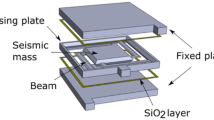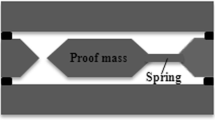Abstract
In this study, the air damping ratios of an unsealed chip of a capacitive accelerometer subjected to different pressures were measured by a special designed circuit in a static state test. There are total eight trapezoid grooves on the top and bottom electrode wafers aiming at reducing air damping effect. Finite element method based on energy balance method and transient blade row model is used to simulate in ANSYS/CFX with a new formula of effective viscosity of the air derived from simulation and validated by experimental results. The numerical results are in good agreement with the experimental results. With the same method and the new formula of effective viscosity, the air damping ratio of a new chip without trapezoid grooves is simulated as well. The comparison of the two kind of chips shows that the air damping ratio decreases 63.4% after four trapezoid grooves were engrooved on the top and bottom electrode wafers. As a result, engrooving on the top and bottom electrode wafers provides a new way to reduce air damping effect.










Similar content being viewed by others
References
ANSYS Inc (2013) ANSYS CFX R15.0 Help manual, CFX: 6.8.3. Case 3: Blade Flutter
Bao M, Yang H (2007) Squeeze film air damping in MEMS. Sens Actuators A 136:3–27
Bao M, Yang H, Sun Y, French PJ (2003) Modified Reynolds equation and analytical analysis of squeeze-film air damping of perforated structures. J Micromech Microeng 13:795–800
Beskok A (2002) Molecular-based microfluidic simulation models. In: Gad-el-Hak M (ed) The MEMS handbook. CRC Press, Boca Raton, pp 8.1–8.28
Bird G (1996) Molecular gas dynamics and the direct simulation of gas flows. Oxford University Press, Oxford
Chen Ching-Shung, Kuo Wei-Jen (2003) Squeeze and viscous dampings in micro electrostatic comb drives. Sens Actuators A 107:193–203
Elder R, Patil S, Holmes W (2013) Investigation of efficient CFD methods for the prediction of blade damping. In: Proceedings of ASME Turbine technical conference and exposition 2013, San Antonio, Texas USA
Franklin GF, Powell JD, Emami-Naeini A (2009) Feedback control of dynamic systems, Chap 3, 6th edn. Pearson Higher Education, Inc., New Jersey
Fukui S, Kaneko R (1988) Analysis of ultra-thin gas film lubrication based on linearized Boltzmann equation: first report-derivation of a generalized lubrication equation including thermal creep flow. J Tribol Trans ASME 110:253–262
Kim ES, Cho YH, Kim MU (1999) Effect of holes and edges on the squeeze film damping of perforated micromechanical structures. In: Proceedings of the 1999 12th IEEE international conference on micro electro mechanical systems
Kwang JY, Chang YS, Hyup KY et al (2003) High-resolution silicon accelerometer using eutectic bonding. Nanotechnol Conf Trade Show 1:396–399
Li WL (1999) Analytical modelling of ultra-thin gas squeeze film. Nanotechnology 10:440–446
Mehner J, Kurth S, Billep D et al (1998) Simulation of gas damping in microstructures with nontrivial geometries. In: Proceedings of 11th IEEE micro electro mechanical systems. Piscataway (NJ, USA), IEEE, pp 172–177
Mitsuya Y (1993) Modified Reynolds equation for ultra-thin film gas lubrication using 1.5-order slip-flow model and considering surface accommodation coefficient. J Tribol Trans ASME 115:289–294
Moeenfard H (2015) Analytical modeling of squeeze film damping in dual axis torsion microactuators. Surf Rev Lett 22(1):1550006-1–1550006-8
Nigro S, Pagnotta L (2012) Analytical and numerical modeling of squeeze-film damping in perforated microstructures. Microfluid Nanofluid 12:971–979
Pandey AK, Pratap R (2008) A comparative study of analytical squeeze film damping models in rigid rectangular perforated MEMS structures with experimental results. Microfluid Nanofluid 4:205–218
Pandey AK, Pratop R (2004) Coupled nonlinear effects of surface roughness and rarefaction on squeeze film damping in MEMS structures. J Micromech Microeng 14:1430–1437
Pantano MF, Pagnotta L, Nigro S (2013) A numerical study of squeeze-film damping in MEMS-based structures including rarefaction effects. Frattura ed Integrita Struct 23:103–113
Timo V, Heikki K, Lahdenperä J, Tapani T (1995) Equivalent-circuit model of the squeezed gas film in a silicon accelerometer. Sens Actuators A 48:239–248
Veijola T (2006) Analytic damping model for an MEM perforation cell. Microfluid Nanofluid 2:249–260
Yazdi N, Ayazi F, Najafi K (1998) Micro-machined inertial sensors. Proc IEEE 86(8):1640–1659
Zhou Z, Wang X (2011) Analysis of squeeze-film air damping of thick perforated plate in MEMS devices. In: Proceedings of the 6th IEEE international conference on nana/micro engineering and molecular systems, pp 131–133
Acknowledgements
This paper was financially supported by Major subject on Reliability Improvement in China Academy of Engineering Physics (TA060606). The authors would like to take this opportunity to express their sincere appreciation.
Author information
Authors and Affiliations
Corresponding author
Rights and permissions
About this article
Cite this article
Mo, Y., Zhou, H., Xie, G. et al. Investigation of air damping effect in two kinds of capacitive MEMS accelerometers. Microsyst Technol 24, 2017–2023 (2018). https://doi.org/10.1007/s00542-017-3598-z
Received:
Accepted:
Published:
Issue Date:
DOI: https://doi.org/10.1007/s00542-017-3598-z




